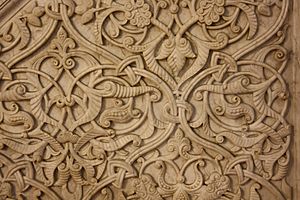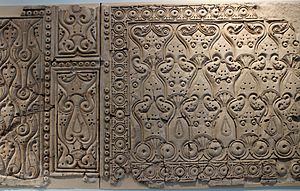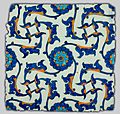Arabesque facts for kids

Arabesque is a beautiful type of decoration or pattern. It uses designs that look like plants, such as leaves and twisting vines, all woven together. Imagine a pattern where lines and shapes intertwine, creating a flowing, endless design.
These patterns often repeat, like tiles on a floor, so they can cover a small area or a very large one.
Art experts use the word "arabesque" to describe special decorations found in Islamic art starting around the 800s. It also describes similar art styles in Europe from the Renaissance period onwards. It's important to know that arabesques are different from Islamic geometric patterns, which use more straight lines and shapes like squares and stars.
Contents
What is an Arabesque?
An arabesque is a kind of art that focuses on decorating surfaces. It often features:
- Intertwining plants: Designs that look like leaves, flowers, and thin, curling plant stems (called tendrils) that weave in and out of each other.
- Flowing lines: Sometimes, it uses simple, smooth lines that connect and repeat.
The idea is to create a continuous pattern that can be extended forever. It's like a puzzle piece that fits perfectly with copies of itself.
Where Can You Find Arabesques?
Arabesques are famous in different parts of the world and in different time periods.
Arabesques in Islamic Art
In Islamic art, arabesques are very common. They are used to decorate:
- Mosques and palaces
- Books and carpets
- Pottery and metalwork
This style became popular around the 9th century. Islamic art often avoids showing people or animals, so artists used beautiful patterns like arabesques and geometric designs to decorate buildings and objects. These patterns often symbolize the endless nature of God.
Arabesques in European Art
After the Islamic world, arabesques also became popular in Europe, especially during the Renaissance (around the 14th to 17th centuries). European artists were inspired by the intricate designs they saw. You can find European arabesques in:
- Paintings and frescoes (wall paintings)
- Furniture and textiles
- Architecture, like palaces and grand homes
European arabesques sometimes included other elements, like mythical creatures or human figures, mixed in with the plant patterns.
Arabesques vs. Geometric Patterns
It's easy to confuse arabesques with Islamic geometric patterns, but they are different:
- Arabesques: Focus on organic, flowing shapes, like leaves, vines, and curves. They feel more natural and plant-like.
- Geometric patterns: Use strict mathematical shapes like stars, squares, hexagons, and circles. They are very precise and often form complex, repeating grids.
Both styles are beautiful and often used together in Islamic art to create amazing designs.
Images for kids
-
Part of a 15th-century ceramic panel from Samarkand (Uzbekistan) with white calligraphy on a blue arabesque background
-
The "Tellus Panel" from the Ara Pacis, in Rome, circa 27 AD. The lower part of the panel is an example of a Roman arabesque
-
Design for a Louis XVI style arabesque, by Étienne de La Vallée Poussin, circa 1780-1793, pen and gray and brown ink, brush and colored wash, in the Metropolitan Museum of Art
-
Three modes: arabesques, geometric patterns, and calligraphy used together in the Court of the Myrtles of Alhambra (Granada, Spain)
-
The French sense of arabesque: a Savonnerie carpet in the Louis XIV style, circa 1685-1697, made of wool, in the Metropolitan Museum of Art (New York City)
-
What is called the "Arabesque Room" in the Catherine Palace, with neoclassical grotesque decoration
-
Mosaics on the Treasury Dome of the Great Mosque of Damascus, 789, still in essentially Byzantine style
-
Ivory pyxid, 10th century, in the Louvre
-
Panel with horse heads, 11th century, in the Metropolitan Museum of Art (New York City)
-
Ottoman tughra of Suleiman the Magnificent, with flowers and saz leaves, 1520
-
Iznik tiled lunette panel that may have come from the Piyale Pasha Mosque in Istanbul, 1570-1575, in the Victoria and Albert Museum from London
-
French arabesque garden planting at Vaux-le-Vicomte, in low box hedges on pink gravel
-
French 18th century Neoclassical grotesque decor at Chateau de Fontainebleau; this would probably have been described as arabesque by its makers
-
Neoclassical arabesques in the Tullgarn Palace from Sweden
-
Renaissance Revival cast iron door window grill of a building on the Boulevard du Temple from Paris
-
Arabesque with a mascaron and a cartouche, on a façade of an 1890s or 1900s city-house from Bucharest
-
Art Nouveau arabesque on a façade of a city-house from Bucharest
See also
 In Spanish: Arabesco para niños
In Spanish: Arabesco para niños




























